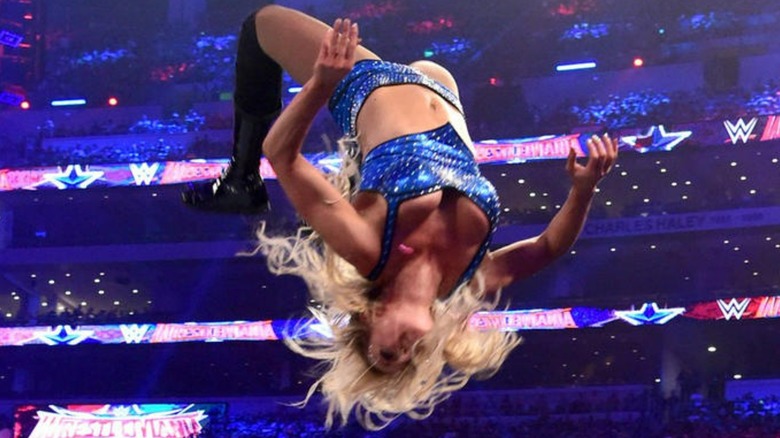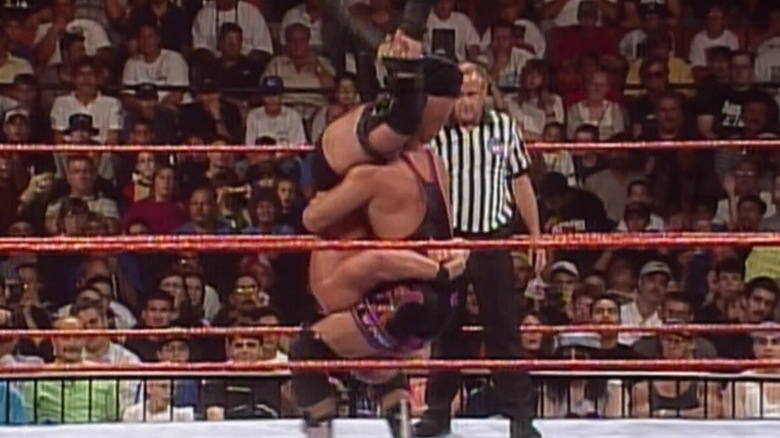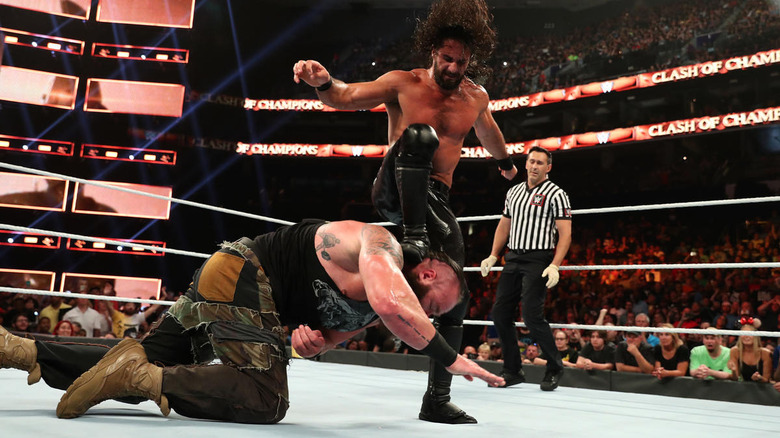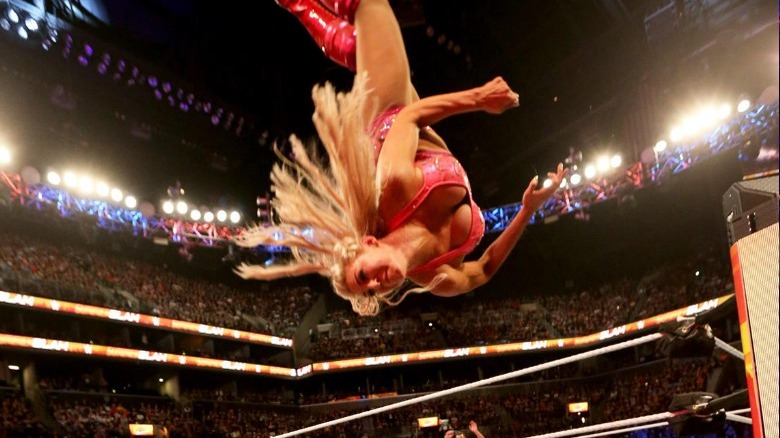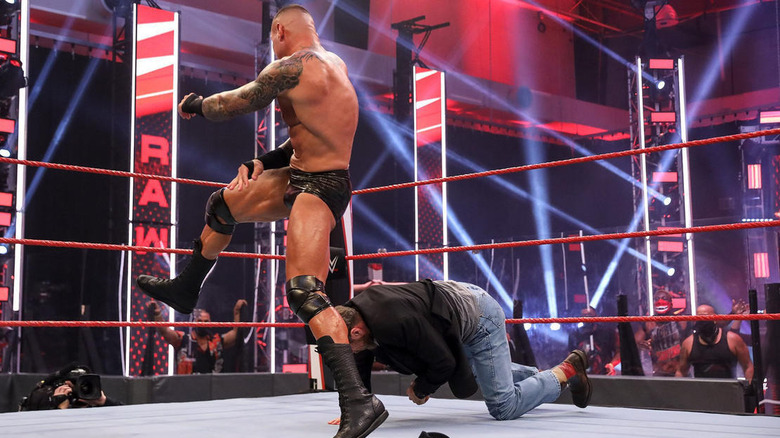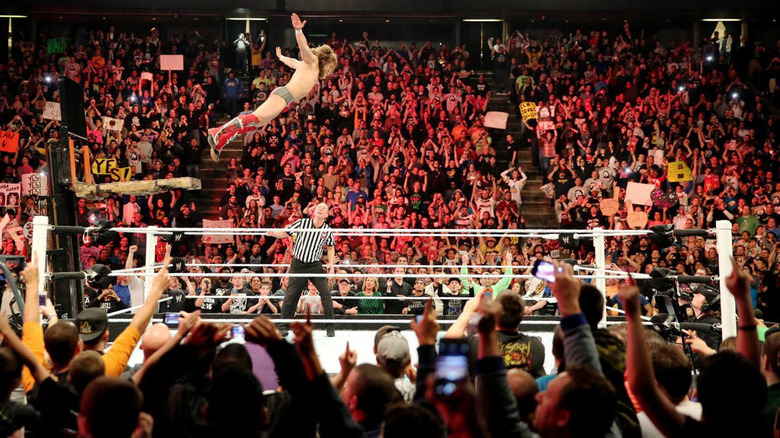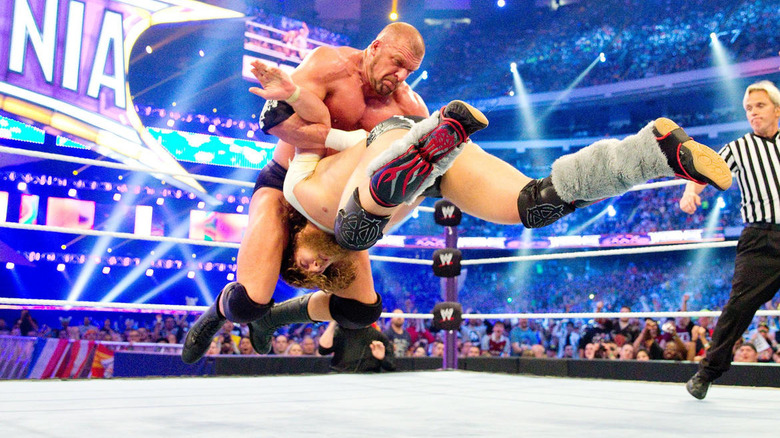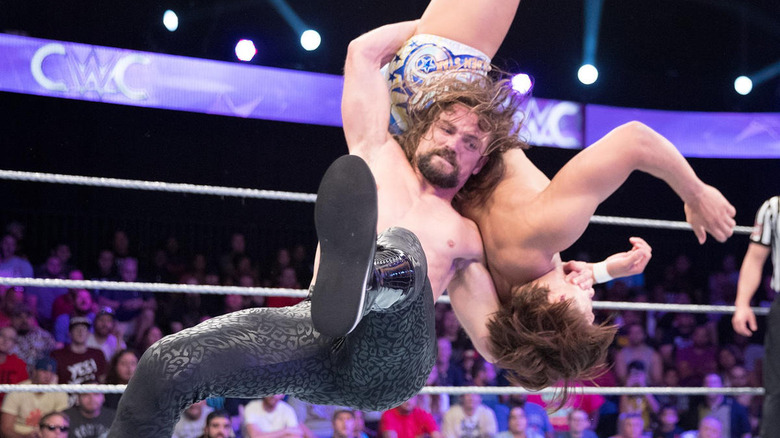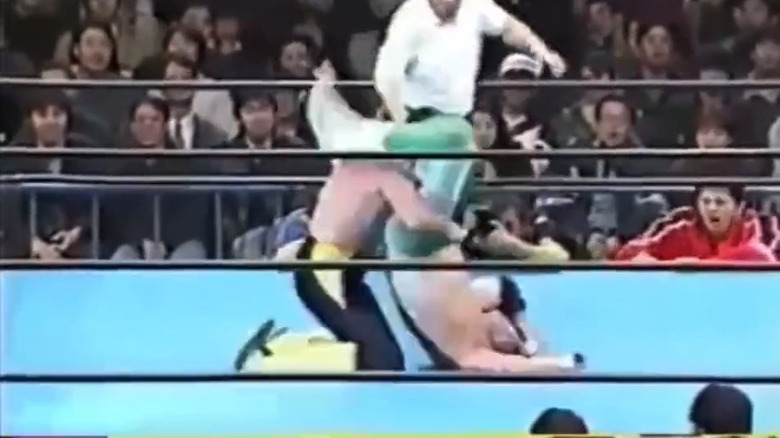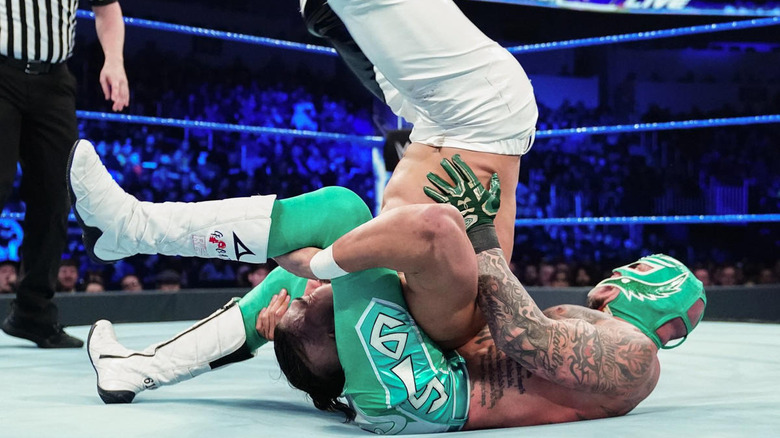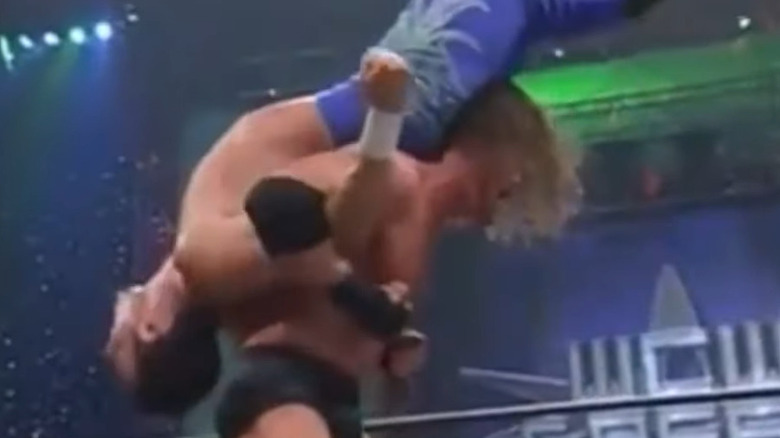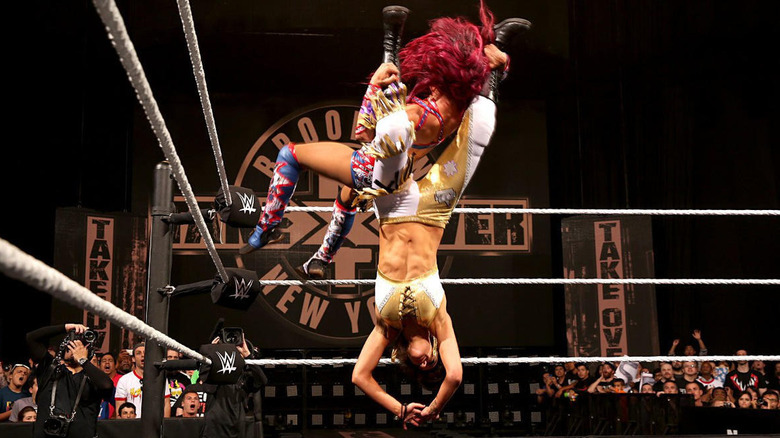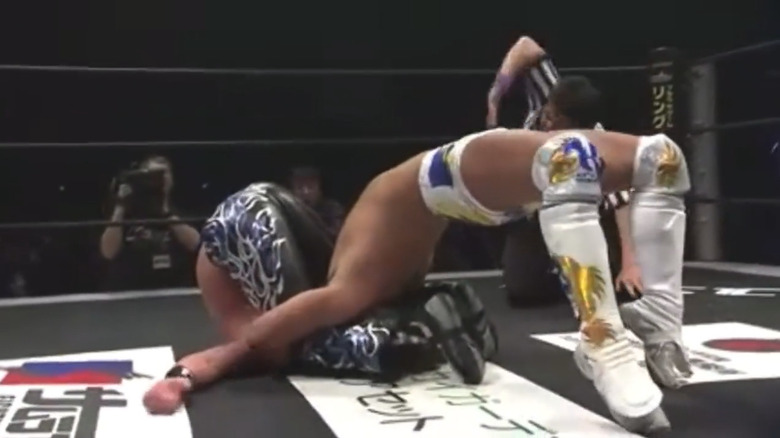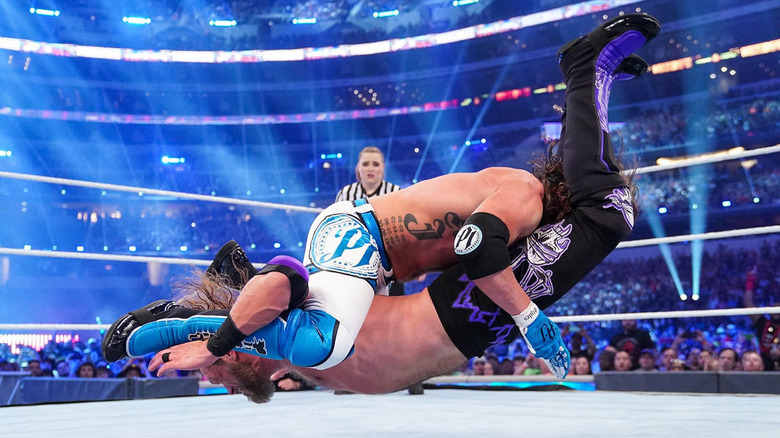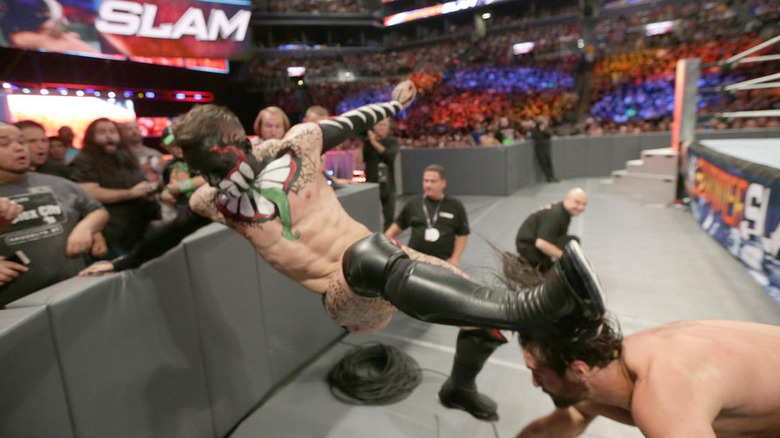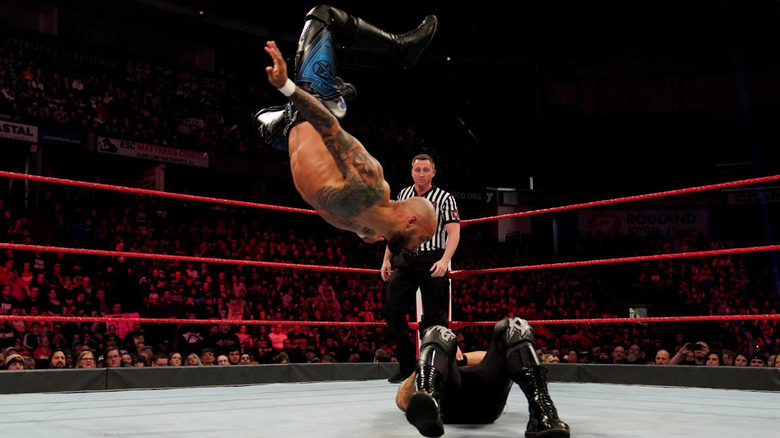The Most Dangerous Wrestling Moves Of All Time
In wrestling, moves are the building blocks that are meant to tell a story once strewn together in the ring. The moves that a wrestler is capable of performing makes them stand out from the rest of the pecking order, wowing the audiences with peak physical strength, toughness, and speed. For a wrestler to adopt the move as a finisher, they have to be able to perform it consistently and safely. Some moves become synonymous with the wrestler who makes them most famous, being protected as to not diminish its value by having someone on the undercard perform it. Wrestlers spend years conditioning their bodies to take these moves that would leave ordinary people crippled. A workout regime can include exercises to reinforce their neck, brutal cardio routines, and other drills meant to improve mobility. All of this is done to reduce the risk of injury and to preserve longevity for the competitor, both in and out of the ring.
Even with this in mind, there are moves that offer a significant risk no matter how skilled the performer is in executing it. Promotions will ban their talent from using moves as a form of risk prevention, as no pop is worth someone having to endure a life-altering injury. With this in mind, there are always dangers when performing and accidents can happen in the most rehearsed of spots. These are trained professionals who've dedicated years of their lives to be able to withstand the most dangerous moves in wrestling.
Piledriver
"Wild" Bill Longson is credited with innovating the piledriver, which sees a wrestler hoist an opponent upside down and spiking them on the mat. The danger comes from potentially compressing the opponent's spine by dropping them on their head. The move is banned in many territories worldwide, leading to a disqualification and even a fine. Jerry Lawler performed the move, forbidden by Tennessee's athletic commission, on Andy Kaufman in 1982. The comedian wore a neck brace in public to sell his "injury," including their infamous confrontation on "Late Night with David Letterman." During an Intercontinental Championship defense in 1997, Owen Hart hit Steve Austin with a sitout tombstone, which left The Texas Rattlesnake temporarily immobile. While on tour with NJPW in 1992, Austin had broken Masahiro Chono's neck in similar fashion. The injury caused Austin to miss most of 1997 and contributed to his early retirement in 2003.
WWF banned all piledriver variations in 2000. Under questioning from the House of Representatives in 2007, Stephanie McMahon revealed that only two wrestlers (almost certainly The Undertaker and Kane) were exceptions, saying those "who have done these maneuvers for a longtime, really know how to do them safely." CM Punk used the move in a 2013 "Raw" match with John Cena, with Vince McMahon being reportedly furious upon witnessing his top draw in such a position. When asked about management's reaction, Punk tweeted in 2020 "people were mad but if you really think about it they're big babies." Kevin Owens teased his Package Piledriver variant throughout his rookie year.
Curb Stomp
The Curb Stomp was innovated by Naomichi Marufuji, which sees the user run towards a staggered opponent and place their foot on behind their neck to drive them into the ground. Seth Rollins adopted the move from Marufuji, using it as his finisher on NXT and the main roster. While Rollins was WWE World Heavyweight Champion in 2015, the move was banned. In lieu of the ban, Rollins tried several other finishers including the Pedigree and fan-dubbed Rain-Trigger. During an episode of "Talk is Jericho" Rollins explained that children imitating the move at home could spark lawsuits. There's also the liability for head trauma, with WWE challenged with a concussion lawsuit earlier that year.
Additionally "Curb stomps" have been reported in numerous acts of racial street violence, seeing the victim have their head smashed against the sidewalk leading to mutilation and even death. On Martin Luther King Jr. Day in 2014, Rollins pinned Big E when the move was still called "The Blackout." The entendre wasn't lost on E, who commented on the moment in a tweet in 2020.
The embargo was lifted in 2018, with Rollins using it to win a match against Finn Balor on "Raw." Rollins told the story of how he was able to get the move reinstated to TheWrap, convincing Vince McMahon on one of the Chairman's good days. Due to the mentioned criminal connotation, the name was shortened to just "The Stomp." Alternative versions of the move have been used by Super Dragon and Simon Dean.
Moonsault
Mando Guerrero is credited with inventing the moonsault press, in which the performer faces away from their opponent and does a backflip onto them. The move was popularized by Lanny Poffo and The Great Muta, with several variations innovated by many others, including Ultimo Dragon.
Once the ace of Japan's FMW, Hayabusa's career ended after a botched springboard moonsault on Mammoth Sasaki. Upon launching himself off the ropes, Hayabusa was unable to rotate completely and landed on top of his head. He spent most of his life after this in a wheelchair, regaining his ability to walk after a successful surgery in 2011. He died at 47 in 2016 due to a brain hemorrhage. Chris Jericho, who popularized the move in the US as the Lionsault, nearly met the same fate but was saved by Curt Hennig. Jericho posthumously thanked Hennig in a 2013 tweet.
Indie wrestler Charade went viral after suffering a fractured skull from a failed moonsault. Miraculously, Charade was able to weakly kick out of a pinfall but lost after a subsequent pinfall attempt. Beyond Wrestling held a fundraiser, raking in $1,200 for his medical bills.
Lance Archer suffered a neck injury in a tournament match with Eddie Kingston, landing on his head after a moonsault. He was off television from October 2021 to the following January. Archer thanked AEW's medical team for helping him recuperate, saying if some factors were different "I probably would have been paralyzed or dead. I'm beyond blessed that didn't happen."
Punt Kick
One of the earliest instances of a punt kick in wrestling occurred in 1985, when Arn Anderson hit one on Buzz Sawyer. Speaking on the angle on his podcast, Arn Anderson said that while he wanted to put Sawyer away, he didn't want to cripple him. While working as an agent for WWE, Anderson handed down it to Randy Orton. First used in 2003, Mick Foley was kicked down a flight of stairs by the Legend Killer. Orton began using the punt regularly in 2007, kicking Shawn Michaels in the head to write him off television. As Orton evolved into The Viper, the punt was used on wrestlers and innocent bystanders as a storytelling device to give kayfabe concussions. Due to legitimate head trauma concerns, the move was banned in 2012 per a tweet by Orton. In spite of the ban, Orton used it at the following year's Survivor Series against The Big Show.
While Orton can be credited for popularizing the move, he isn't the only one to use it. KENTA used the punt kick in his stiff shoot-style arsenal. During an interview with talkSPORT, Orton discussed how he was able to get the move unbanned in spite of concussing the Chairman with it in 2009. Orton began using the move prominently again in 2020, beating Edge with it at Backlash. John Cena Sr., who took the punt in 2007, spoke out against the ban being lifted and called it "not a good move."
Diving Headbutt
Harley Race is credited with the invention of the diving headbutt, accidentally performing the move after falling from the top rope but adding it to his arsenal upon hearing the crowd's reaction. Notable users include Dynamite Kid, Chris Benoit, and Bryan Danielson. Benoit in particular performed headbutts off cages and ladders in death-defying feats throughout his career. Tomoaki Honma performs a Kokeshi variant of the move, which sees him stiffen up and plunge onto his opponents.
The aforementioned users have suffered head and spinal trauma over the course of their careers. Race opposed to the usage of the move, blaming years of landing on his abdomen for causing future health problems. Dynamite Kid suffered numerous spinal injuries, which combined with his drug addiction, left him wheelchair-dependent by age 40. Danielson retired in 2016 due to concussion and neck problems, returning to the ring in 2018 after being cleared by multiple non-WWE doctors. Honma suffered damage to his vertebrae after taking a hangman's DDT in 2017. Benoit sat out most of 2001 due to a spinal injury. He died in 2007 in a tragic double murder-suicide, with many mental health problems in the last years of his life attributed to CTE.
For what it's worth, Kurt Angle, a notable fight partner of Benoit, has disputed claims of the move's liability for head trauma. Angle claims on his podcast (h/t Sportskeeda) that the worst thing Benoit endured from performing the move is the "whiplashing to your back and neck."
Pedigree
Triple H's Pedigree is one of the most protected moves in history. Fightful reports that the finisher was adopted by Helmsley during his time training under Killer Kowalski. However, the original version had both the victim's arms hooked the entire way through, limiting their ability to protect their face.
At a 1996 "Superstars" taping, Marty Garner spiked himself on the mat and injured his neck believing he was taking a piledriver or suplex. Another botch occurred when Triple H faced Kurt Angle and defending WWF Champion The Rock at SummerSlam 2000. Helmsley and Angle had been vying for the love of Stephanie McMahon, with The Game hoping to take his pound of flesh by Pedigreeing Angle on the announce table. While setting up the spot, the table collapsed in on itself to the surprise of both. Reflecting on the incident on "Impaulsive," Helmsley recalled checking in on Angle and hearing the Olympian snoring as he knocked himself out on a monitor. The match continued, but Helmsley has expressed regret now knowing the long term consequences of brain trauma.
Triple H has adjusted his delivery of the Pedigree over the years, releasing his opponent's arms so they can protect themselves upon impact. Lance Storm tweeted about how Triple H told him how to take The Pedigree, not wanting to repeat Garner's accident and released his arms before they landed. Pupils of Helmsley have adopted the move since, including Seth Rollins and even Randy Orton one time.
Burning Hammer
The Burning Hammer was first used by Kenta Kobashi against Mitsuharu Misawa in October 1998. Outside of a few hollow victories, Kobashi hadn't beaten Misawa on this big of a stage. It was a last ditch effort by Kobashi to get a win over the ace, who carried the promotion throughout the decade. Kobashi performed the move only seven times in his career, getting the victory each time. The danger of the move comes from the recipient having to land on their head and shoulders, risking severe head and spinal injury. The King's Road style became increasingly dependent on these dangerous spots, many of its practitioners now suffering from health problems. Head bumps are believed to have contributed to Misawa's early death in 2009, with an autopsy reporting he had sustained years of cervical spinal trauma.
The maneuver was allegedly banned by WWE, but modified variants have been adopted by Tyler Reks and Trent Seven. These versions allow for the opponent to rotate with greater control and ensure it can be executed safely and regularly. In the quarterfinals of the Cruiserweight Classic, Brian Kendrick performed the move on Kota Ibushi (who has a history of neck injuries) to the surprise of even the commentators. AJ Styles did a Burning Hammer during an episode of "Raw" in September 2021, beating Riddle.
Ganso Bomb
The Ganso Bomb as we know it debuted in a January 1999 match between Toshiaki Kawada and Mitsuharu Misawa, where Kawada suffered a broken ulna in his right arm. Kawada attempted a powerbomb but was unable to hoist Misawa in position, leaving his opponent dangling upside down. In a desperate attempt to beat his high school classmate-turned archrival ace, Kawada dropped Misawa on his head to land the first ever Ganso Bomb. Introduced a few months after the Burning Hammer, the Ganso Bomb opened the floodgates to the next chapter of the King's Road style. Matches became head-spiking bouts of one-upmanship, pushing the boundaries of what the body can endure. Despite its devastating impact, Kawada never won a match with the move and rarely performed it. Years of constant head and neck trauma are believed to have contributed to Misawa's death in the ring.
While Kawada is credited with inventing the Ganso Bomb, similar moves can be traced back to a WWF match between Rick Rude and The Ultimate Warrior. Over the years, multiple botched powerbombs have turned into Ganso Bombs. During an episode of "WCW Nitro," Booker T attempted a powerbomb from the top rope on Mortis but Mortis over-rotated and fell on his neck. Super Dragon accidentally performed the move on Jack Evans in a PWG match. John Cena nearly did a Ganso Bomb to Daniel Bryan during their WWE Championship main event at SummerSlam 2013.
Canadian Destroyer
The Amazing Red is credited with creating the Flip Piledriver in a match with Joel Maximo. Petey Williams popularized the move in TNA, making him a standout among the fledgling X Division. Subject to WWE's piledriver ban, the company has softened on its stance in recent years. Rey Mysterio and Chelsea Green (who Williams endorsed in 2018) were given the green light to use the move. With only months of training, Bad Bunny used the Destroyer during his WrestleMania 37 debut match. Even veterans like Ricky Morton and Dustin Rhodes have used Destroyers despite being in the twilight of their careers. It's also increasingly common. Williams and Gail Kim took to Twitter to complain about the move's overabundance. Critics have called Destroyers overused in the current wrestling landscape and Williams has even apologized.
The previously mentioned risks of a piledriver are emphasized here, as the victim is required to backflip with their opponent's weight on their neck. At a November 2017 GCW show, Marko Stunt broke his leg on a stool while crashing through a door during a Destroyer performed by Eli Everfly. On Twitter, Stunt confirmed the injury and his planned surgery. During a deathmatch in Colorado, Benny Cumberbatch was critically injured after taking a Canadian Destroyer off a balcony through a pile of debris. A GoFundMe was launched and Primos Premier Pro Wrestling used its tournament proceeds to cover Cumberbatch's medical costs. Cumberbatch, real name Austin Ramos, has documented his road to recovery on Instagram.
Vertebreaker
Megumi Kudo is credited with creating the Kudome Valentine finisher, known to most as the Vertebreaker. The setup is complex, with the user underhooking their opponent's arms from behind and dropping them on their back in a seated position. Since it restricts one's arms, the victim is unable to protect themselves as they take most of the impact on their back and neck. WWE banned the Vertebreaker in its sweep to avoid neck injuries caused by piledrivers. When asked by a fan on Twitter why he stopped using the move, Hurricane Helms summarized with "I pled my case for about 30 seconds, realized it wasn't gonna go my way, so I just said okay." In an interview with Fightful, Helms went into more detail saying "there was only about three people I could even pick up ... so it wasn't a big deal for me." Helms has taken pride in not injuring anyone, tweeting in 2020 "It's not the move, it's the execution."
During a WWE Live Event in 2016, Seth Rollins used the move on AJ Styles. The footage got tons of attention as the first instance of a Vertebreaker being done in a WWE ring in over a decade. Styles was one of the last people to take the hold on WWE television, facing Helms on an episode of "Metal" in 2002.
Reverse Frankensteiner
The reverse frankensteiner sees the user sit on their opponent's shoulders and fall backwards, causing the victim to backflip. Compared to a normal frankensteiner, one is at greater risk of spiking themselves if they don't fully rotate. The move is also known as a poisoned hurricanrana, with Chris Hero claiming the name comes from the word "rana" which is Spanish for frog. In a 2018 tweet, Jim Cornette called the reverse hurricanrana "the stupidest move in wrestling."
During their Women's Championship classic at the inaugural "NXT Takeover: Brooklyn," Bayley performed a poison-rana from the top rope on Sasha Banks. The move was a novelty, previously unseen in WWE's women's division. Bayley reflected on the spot with Fightful, recalling that she doubted she could even do the move but still pulling through to give Banks "the match of her life." Rumors floated of Banks suffering an injury from the spot, but she denied those claims on social media.
Others weren't so lucky. Noam Dar and Mark Andrews wrestled to a no-contest during a February 2019 "NXT UK" taping, with Dar carted off after a botched reverse frankensteiner. Dar faced amputation of his leg and was out of action for two months.
During a February 2022 episode of "Dynamite," CM Punk took on MJF and spiked his head during an attempted poison-rana. Punk was able to complete the match without injury. Since Punk is a few inches taller than MJF, one can attribute the height difference for making it harder for Punk to safely perform the move.
Phoenix-Plex
The bridging fallaway suplex sees the user put their opponent in a powerbomb position. Rather than dropping them forward to take a back bump, the user bridges backwards to drop the victim on their head and shoulders. Since the move lacks the same control as a traditional powerbomb or suplex, there is a risk of spinal injury especially if the user isn't able to perform a proper bridge. Kota Ibushi and Samuray Del Sol are known to use the move. In an interview with Fightful, Kevin Owens explained that his decision to stop using the Steenalizer — his variation — came down to safety measures. Opponents would seldom agree to take the move on the indies and given WWE's constant schedule, "it's not a move you want to give ... on a daily basis."
In 2018, Dragon Lee challenged Hiromu Takahashi for the IWGP Junior Heavyweight Championship. The two rivals kept the historic Cow Palace on its feet with an athletic junior heavyweight-style bout, as they had done before across the Pacific. The match was nearly halted when Lee overshot Takahashi during a Phoenix-Plex, sending the LIJ member on his skull. Reports from Fightful claimed Takahashi had suffered a broken neck, despite retaining the title. In an interview with NJPW's website, Takahashi recalled believing his career to be over but persevering as to not ending it on a potentially bad note. Takahashi returned over a year and a half later at Power Struggle to challenge Will Osperay for the title.
Styles Clash
The Styles Clash is synonymous with AJ Styles, who has used the move since the early days in NWA-TNA. Rather than tucking their head in like most bumps, the victim is expected to stretch their neck out upwards. The first major accident involving the move was in a 2003 TNA encounter with Frankie Kazarian, with another instance in 2006 involving Sterling James Keenan. Returning to ROH at a January 2014 taping, Styles took on Roderick Strong. Strong landed on his head and was treated for his injuries by medics, per Cageside Seats. Due to the injury, Strong was forced to withdraw from an EVOLVE show held later that month. That April, Lionheart suffered a broken neck due to a botched Styles Clash. In November of that year, Yoshitatsu suffered a neck injury after incorrectly taking the move, requiring surgery. He would record his recovery process on Twitter, returning in a dual commentary-wrestler role.
First used in WWE rings by Michelle McCool as "The Faithbreaker," the Styles Clash was reportedly subject to a ban due to its track record of hurting wrestlers. Styles contested rumors of the ban in a March 2016 tweet. In spite of this, Chris Jericho claims to have helped get the ban lifted, selling it to Vince McMahon as "that cool move that AJ does where he drops you on your face."
Buckle Bomb
The Buckle Bomb is a move where the safety is dependent on the spacing in the ring and timing of the performers. If one doesn't land on their feet, the brunt of the impact is placed on their spine and neck. At Night of Champions 2015, Sting challenged Seth Rollins in his first WWE Championship match. During their encounter, Rollins used the Buckle Bomb on The Icon and the match was halted. After medical staff tended to the veteran, the bout continued with Rollins retaining. Sting suffered a neck injury, calling it a "freak accident" on Bill Apter's podcast and holds no animosity towards Rollins. The injury would mark the end of Sting's WWE in-ring career, headlining the 2016 Hall of Fame after only four matches. At SummerSlam 2016, Rollins took on Finn Balor to crown the first Universal Champion. In the ringside area, Rollins hit Balor with a Buckle Bomb on the barricade. Balor suffered a shoulder injury and relinquished the title the following evening. Rollins faced a smear campaign calling him an unsafe worker despite apologizing for Sting's injury. Balor has also denied these claims, considering the years of wear-and-tear wrestlers face that can instigate accidents like these.
During a "Raw" match in April 2020, Nia Jax attempted a Buckle Bomb on Kairi Sane with Sane being sent neck-first into the bottom turnbuckle. While Jax didn't injure her, there was a precedent for similar accidents and the move has reportedly been banned in the company.
Shooting Star Press
Jushin "Thunder" Liger is credited with inventing the Shooting Star Press, which sees the user face their opponents and perform a backflip into a body press. Billy Kidman was one of the first Americans to use the move on television, a trailblazer for future high-flyers in that regard. However, Kidman had a penchant for injuring himself and others. During an August 2004 "SmackDown" taping, Kidman's knee landed on Chavo Guerrero's face and knocked him out cold. Guerrero was diagnosed with a concussion, taking two months off television to recover. The accident was turned into an angle, but the move was shelved by management. Paul London used a Shooting Star Press on Nunzio during a "Velocity" show, leading to an argument with Vince McMahon, as he told "Cafe de Rene." In his AEW debut, Matt Sydal botched the move as he performed it on ring ropes slick from the Floridian humidity.
In spite of his size, Brock Lesnar used the move as his finisher in OVW. Lesnar pulled out the move as a last resort in his main event match with Kurt Angle at WrestleMania XIX. Angle was too far from Lesnar to safely land, but he still attempted it and fell on his head. Lesnar has since called the move "foolish," and thanked Angle for helping him get through the night. Angle fondly remembers the match, telling Chris Van Vliet that it was a "great moment" for Brock and the most memorable from the card.
